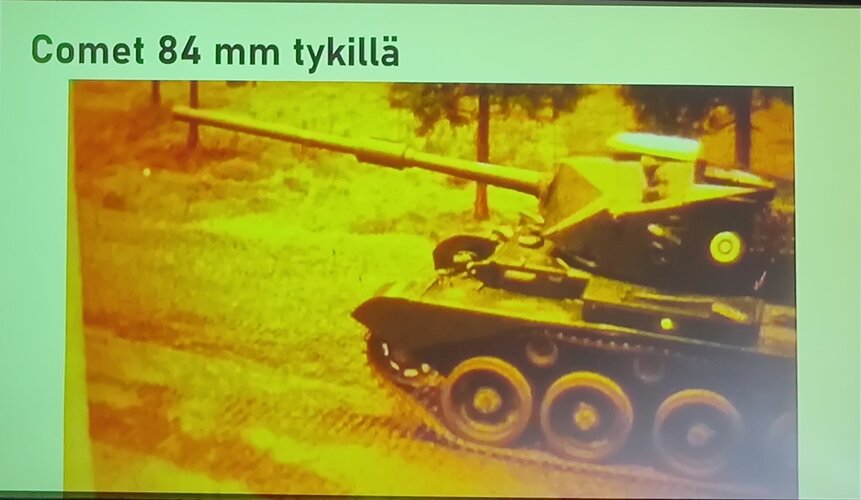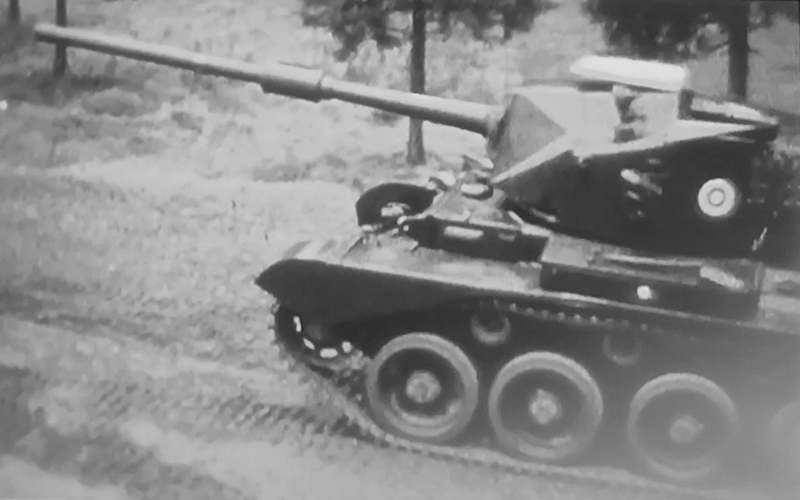blockhaj
Swedish "want to be" aviation specialist
- Joined
- 9 February 2017
- Messages
- 366
- Reaction score
- 429
During the early 1960s the Finnish army had a project for retrofitting their A34 Comet I tanks (finnish armor number: Ps. 252) with 84 mm 20pdr guns from their Charioteers (Ps. 251), turning them into tank destroyers (finnish: panssarintorjuntavaunu, short pstv). The idea seems to have started with the Finnish Army wanting to upgrade their Charioteers with British 105 mm L7 guns, then reusing their 20pdr guns on the Comets. Company Lokomo Oy built a prototype ready for the fall of 1962, but the project quickly died when the British didn't want to sell the 105 L7 gun to Finland. There was also some idea to build some indigenous 105 mm L7 tank destroyer, which also died here.
I have only ever found one image of the prototype, more info and photos on the conversion would be greatly appreciated.


Original to the left, correction attempt to the right.
Here is a finnish PDF talking about the project: https://www.utupub.fi/bitstream/handle/10024/146199/Piesala_Aki_Opinnayte.pdf?sequence=1&isAllowed=y
Below is a basic Google translate of the text, but marking the text for translating leaves out some words. Expect errors.
Basic Google translate of the text, expect errors.
In the summer of 1961, however, the previously optimistically planned acquisition of British 105 mm cannons ran into problems. Answers from de Jersey & Co, who acted as an intermediary, regarding the connection of the success of the road procurement to additional Cometie orders. Regarding the 105 millimeter cannons and possibly also the tracked platforms, as well as the Charioteer-like cannons, the British Ministry of War was now approached. Regarding cannons, however, the answer was no, even if it was important.
At the end of the same year, at the initiative of the long-range defense committee, which has now gained a more established position, a trial of the Comet platform was presented by installing Charioteer's cannon on it. At the same time, however, the infantry department expressed its own, slightly different position on the benefits of the experiment. In the department's statement, doubts were expressed about the suitability of the solution as a top weapon for long-range defense due to the height of the carriage, in other words, the vulnerability, and the slight obsolescence of the Charioteer cannon. For this reason, however, it was considered important to continue the experiments through the prototype.
Above all, however, the infantry department was excited about the potential of the Comet conversion as an inexpensive way to both get some sort of combat value from the Comets and increase the ranged defense capability a bit. The weapon planning committee's plan in the spring of 1962 for the use of a combination of the Comet chassis and the Charioteer cannon presented a purely objective improvement of the Comets' anti-tank capability by replacing their inadequate original cannon with the Charioteer cannon. Thus, the goal of the entire project was changed to a slightly different one.
When the modification work was successfully completed by Lokomo in the fall, the remote control committee presented as alternatives either the modification work of all or only a part of the Comet wagons, or the use of the wagons as such in secondary tasks. Changing all the carriages would of course have been the most expensive option. In all options, the Comets would have been used by the anti-tank battalions, like the Charioteers.
However, the situation regarding the implementation of the change work had clearly changed. The previously available used cannons planned for the conversion work were no longer available in Great Britain, so acquiring new cannons would be more expensive and production would take time, although it was believed that the acquisition could be speeded up through diplomatic means.
Domestic production was also considered possible, but due to the small number of cannons, it was not considered possible to achieve a real advantage. When it became clear that the British were not ready to sell cannons at least before the middle of the current decade, the idea of using Comets as anti-tank vehicles was also abandoned.
In 1965, the weapons design committee decided to work on the Comet's gun reform "because it was a lot", and the issue was never returned to.
I have only ever found one image of the prototype, more info and photos on the conversion would be greatly appreciated.


Original to the left, correction attempt to the right.
Here is a finnish PDF talking about the project: https://www.utupub.fi/bitstream/handle/10024/146199/Piesala_Aki_Opinnayte.pdf?sequence=1&isAllowed=y
Below is a basic Google translate of the text, but marking the text for translating leaves out some words. Expect errors.
Basic Google translate of the text, expect errors.
In the summer of 1961, however, the previously optimistically planned acquisition of British 105 mm cannons ran into problems. Answers from de Jersey & Co, who acted as an intermediary, regarding the connection of the success of the road procurement to additional Cometie orders. Regarding the 105 millimeter cannons and possibly also the tracked platforms, as well as the Charioteer-like cannons, the British Ministry of War was now approached. Regarding cannons, however, the answer was no, even if it was important.
At the end of the same year, at the initiative of the long-range defense committee, which has now gained a more established position, a trial of the Comet platform was presented by installing Charioteer's cannon on it. At the same time, however, the infantry department expressed its own, slightly different position on the benefits of the experiment. In the department's statement, doubts were expressed about the suitability of the solution as a top weapon for long-range defense due to the height of the carriage, in other words, the vulnerability, and the slight obsolescence of the Charioteer cannon. For this reason, however, it was considered important to continue the experiments through the prototype.
Above all, however, the infantry department was excited about the potential of the Comet conversion as an inexpensive way to both get some sort of combat value from the Comets and increase the ranged defense capability a bit. The weapon planning committee's plan in the spring of 1962 for the use of a combination of the Comet chassis and the Charioteer cannon presented a purely objective improvement of the Comets' anti-tank capability by replacing their inadequate original cannon with the Charioteer cannon. Thus, the goal of the entire project was changed to a slightly different one.
When the modification work was successfully completed by Lokomo in the fall, the remote control committee presented as alternatives either the modification work of all or only a part of the Comet wagons, or the use of the wagons as such in secondary tasks. Changing all the carriages would of course have been the most expensive option. In all options, the Comets would have been used by the anti-tank battalions, like the Charioteers.
However, the situation regarding the implementation of the change work had clearly changed. The previously available used cannons planned for the conversion work were no longer available in Great Britain, so acquiring new cannons would be more expensive and production would take time, although it was believed that the acquisition could be speeded up through diplomatic means.
Domestic production was also considered possible, but due to the small number of cannons, it was not considered possible to achieve a real advantage. When it became clear that the British were not ready to sell cannons at least before the middle of the current decade, the idea of using Comets as anti-tank vehicles was also abandoned.
In 1965, the weapons design committee decided to work on the Comet's gun reform "because it was a lot", and the issue was never returned to.
